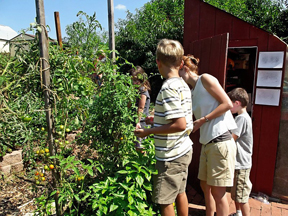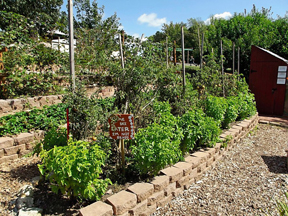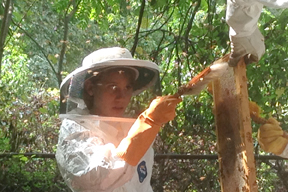The Greensboro Montessori School Gardens
https://thegmsgardens.wordpress.com/
2856 Horse Pen Creek Road
GPG Members Involved: Jenny Kimmel, Eliza Hudson, Sara Stratton, Aubrey Cupit, Charlie Headington, Amy Moyle (bee advisor), Elaine Shields (parking lot oasis design)
Written by: Jenny Kimmel
 Students play and learn in the oasis of gardens throughout each school year and summer at the Greensboro Montessori School, now in its 18th year. The gardens were begun by Dr. Charlie Headington – professor, permaculture teacher, and local activist – in 1997. There has been a tremendous amount of creative work that has gone into creating and maintaining our beautiful and productive gardens. The children, along with faculty, staff, parents, and other volunteers have planted every tree (except for nine really large ones,) moved every load of topsoil and mulch, planted every bulb, watered every seedling, and tended every annual pea, tomato, or flower until it blooms or fruits.
Students play and learn in the oasis of gardens throughout each school year and summer at the Greensboro Montessori School, now in its 18th year. The gardens were begun by Dr. Charlie Headington – professor, permaculture teacher, and local activist – in 1997. There has been a tremendous amount of creative work that has gone into creating and maintaining our beautiful and productive gardens. The children, along with faculty, staff, parents, and other volunteers have planted every tree (except for nine really large ones,) moved every load of topsoil and mulch, planted every bulb, watered every seedling, and tended every annual pea, tomato, or flower until it blooms or fruits.
There are three vegetable and fruit gardens on campus and each has age-appropriate structures, activities, and goals.
PRIMARY GARDENS
 The Primary garden is composed of 12 beds in the front triangle next to the gym. This entire area was once hard-pressed gravel and clay and has responded to liberal doses of leaf mulch, new soil, and wood chips. Students plant and harvest annual vegetables in these beds. The fruit bushes and dwarf fruit trees produce blossoms and fruit and students taste plums, pears, figs, blackberries, cherries, blueberries, persimmons, and strawberries. They’ll see nature in action as birds and friendly insects patrol the organic garden against unwanted pests. Our goal is to create a beautiful, cozy, and productive garden where young children can learn and absorb the diversity and splendor of nature and taste fresh food.
The Primary garden is composed of 12 beds in the front triangle next to the gym. This entire area was once hard-pressed gravel and clay and has responded to liberal doses of leaf mulch, new soil, and wood chips. Students plant and harvest annual vegetables in these beds. The fruit bushes and dwarf fruit trees produce blossoms and fruit and students taste plums, pears, figs, blackberries, cherries, blueberries, persimmons, and strawberries. They’ll see nature in action as birds and friendly insects patrol the organic garden against unwanted pests. Our goal is to create a beautiful, cozy, and productive garden where young children can learn and absorb the diversity and splendor of nature and taste fresh food.
LOWER ELEMENTARY GARDENS
 The Lower Elementary gardens are terraced on a gentle slope. The Lower-El gardeners were so enthusiastic that we doubled the growing spaces! One side is for annual vegetables. The other side is for perennial fruit trees, bushes, and strawberries. Something is growing all of the time, even in winter. We practice four-seasons gardening and cover plants in “hoop tents” to supply lettuce, spinach, cilantro, and other cold weather plants for programming and our farmers market. There are native grape vines on the fence and pear, peach, plum, and fig trees all around. Kiwi vines cover an arbor and a passive solar greenhouse, built by UNCG students, that serves as a shed and germinating house. At lunchtime students sit beneath the limbs of small trees that they planted. The first through third graders love their garden. They planned and planted it; they water it and watch it grow.
The Lower Elementary gardens are terraced on a gentle slope. The Lower-El gardeners were so enthusiastic that we doubled the growing spaces! One side is for annual vegetables. The other side is for perennial fruit trees, bushes, and strawberries. Something is growing all of the time, even in winter. We practice four-seasons gardening and cover plants in “hoop tents” to supply lettuce, spinach, cilantro, and other cold weather plants for programming and our farmers market. There are native grape vines on the fence and pear, peach, plum, and fig trees all around. Kiwi vines cover an arbor and a passive solar greenhouse, built by UNCG students, that serves as a shed and germinating house. At lunchtime students sit beneath the limbs of small trees that they planted. The first through third graders love their garden. They planned and planted it; they water it and watch it grow.
Here are some features you may notice from the pictures:
Variety of Vegetables.
 Some mature in the spring, like snow peas, fava beans and certain greens, some in summer, like lettuce and corn, but real abundance comes in the fall with tomatoes, peppers, basil, beans, okra, paw-paws, and oh so much more.
Some mature in the spring, like snow peas, fava beans and certain greens, some in summer, like lettuce and corn, but real abundance comes in the fall with tomatoes, peppers, basil, beans, okra, paw-paws, and oh so much more.
Terraces and Worms.
 The land is sloped, therefore we formed terraced beds. This not only makes it easier to garden, but more importantly, they capture all of the rain, and help prevent erosion on the hillside. Students like to sit on the walls during lunchtime. At GMS we don’t till the soil. We lay nutritious “worm food” on the beds (rotting leaves, compost, cardboard, grass clippings) and let the worms do the tilling.
The land is sloped, therefore we formed terraced beds. This not only makes it easier to garden, but more importantly, they capture all of the rain, and help prevent erosion on the hillside. Students like to sit on the walls during lunchtime. At GMS we don’t till the soil. We lay nutritious “worm food” on the beds (rotting leaves, compost, cardboard, grass clippings) and let the worms do the tilling.
Insect Islands.
 Notice the islands of perennial plants, herbs, and flowers in the midst of vegetable beds. Part of organic gardening is inviting helpful insects into the garden. They are our first line of defense against harmful insects. What invites them? The sweet flowers of certain plants, called insecticidal plants. Some are as common as daisies and many of them are useful herbs.
Notice the islands of perennial plants, herbs, and flowers in the midst of vegetable beds. Part of organic gardening is inviting helpful insects into the garden. They are our first line of defense against harmful insects. What invites them? The sweet flowers of certain plants, called insecticidal plants. Some are as common as daisies and many of them are useful herbs.
Drip Irrigation.
Water gets scarce in the middle of summer and normal methods of watering are wasteful. We have put in T-tape and drip irrigation tubes that dribble small amounts of water right next to the plants, minimizing evaporation. This saves water and time. Everybody wins!
Compost.
We make compost from old weeds, grass, leaves, and food scraps. When it turns into soil (in 6 months,) it is put back into the garden.
UPPER ELEMENTARY GARDENS
 The Upper School Garden serves 4th-5th graders and the Middle School. Maria Montessori knew that young people want to be active outdoors. Together students have built an ecological pond that operates without a mechanical pump or filter. It cleans and aerates the way nature does, through plants and fish. They have also built a kiwi pergola (our outdoor shade room) and a grape arbor. Again, you’ll see fruit trees, plum, fig, persimmon, and an herb spiral. This garden features a forest garden with guilds of medicinal herbs, insecticidal plants, flowers, and edible perennials underneath fruit trees. The forest garden helps older students learn some of the more complex functions of permaculture.
The Upper School Garden serves 4th-5th graders and the Middle School. Maria Montessori knew that young people want to be active outdoors. Together students have built an ecological pond that operates without a mechanical pump or filter. It cleans and aerates the way nature does, through plants and fish. They have also built a kiwi pergola (our outdoor shade room) and a grape arbor. Again, you’ll see fruit trees, plum, fig, persimmon, and an herb spiral. This garden features a forest garden with guilds of medicinal herbs, insecticidal plants, flowers, and edible perennials underneath fruit trees. The forest garden helps older students learn some of the more complex functions of permaculture.
 Middle school students also manage a hive of Italian Hygienic Honey Bees and use produce from the gardens for their Friday Farm to Fork business. We are constantly planning the vegetables we want on the table in several months. Growing and sharing our own food (and recycling our waste) will complete the seasonal cycle that begins in the worm-worked winter soil.
Middle school students also manage a hive of Italian Hygienic Honey Bees and use produce from the gardens for their Friday Farm to Fork business. We are constantly planning the vegetables we want on the table in several months. Growing and sharing our own food (and recycling our waste) will complete the seasonal cycle that begins in the worm-worked winter soil.
